ECO mode MITSUBISHI OUTLANDER PHEV 2014 Owner's Manual (in English)
[x] Cancel search | Manufacturer: MITSUBISHI, Model Year: 2014, Model line: OUTLANDER PHEV, Model: MITSUBISHI OUTLANDER PHEV 2014Pages: 442, PDF Size: 19.04 MB
Page 337 of 442

NOTElDepending on the type of the USB memory
device or other device connected, the con-
nected device may not function properly or the available functions may be limited.
l It is recommended to use an iPod with firm-
ware updated to the latest version.
l You can charge your iPod by connecting it
to the USB input terminal when the opera- tion mode is in ON or ACC.
l Do not keep your USB memory device or
iPod in your vehicle.
l It is recommended that you back up files in
case of data damage.
l Do not connect to the USB input terminal
any device (hard disk, card reader, memory reader, etc.) other than the connectable devi-
ces specified in the previous section. The de- vice and/or data may be damaged. If any of these devices was connected by mistake, re-
move it after putting the operation mode in OFF.File specifications
E00762401056
You can play music files of the following
specifications that are saved in a USB memo-ry device or other device supporting mass
storage class. When you connect your iPod, playable file specifications depend on the connected iPod.
ItemConditionFile formatMP3, WMA, AAC,
WAVMaximum number of levels
(including the root)
Level 8
Number of folders700Number of files65,535Sun visors
E00711202277
1- To eliminate front glare2- To eliminate side glare
Vanity mirror
A vanity mirror is fitted to the back of the sun visor.
Operating the lid of the vanity mirror will au-
tomatically turn on the mirror lamp (A).CAUTIONl If the lid of vanity mirror with lamp is kept
open for prolonged periods of time, the aux-
iliary battery will be discharged.
Sun visors
8-69OGGE14E5For pleasant driving8
Page 339 of 442
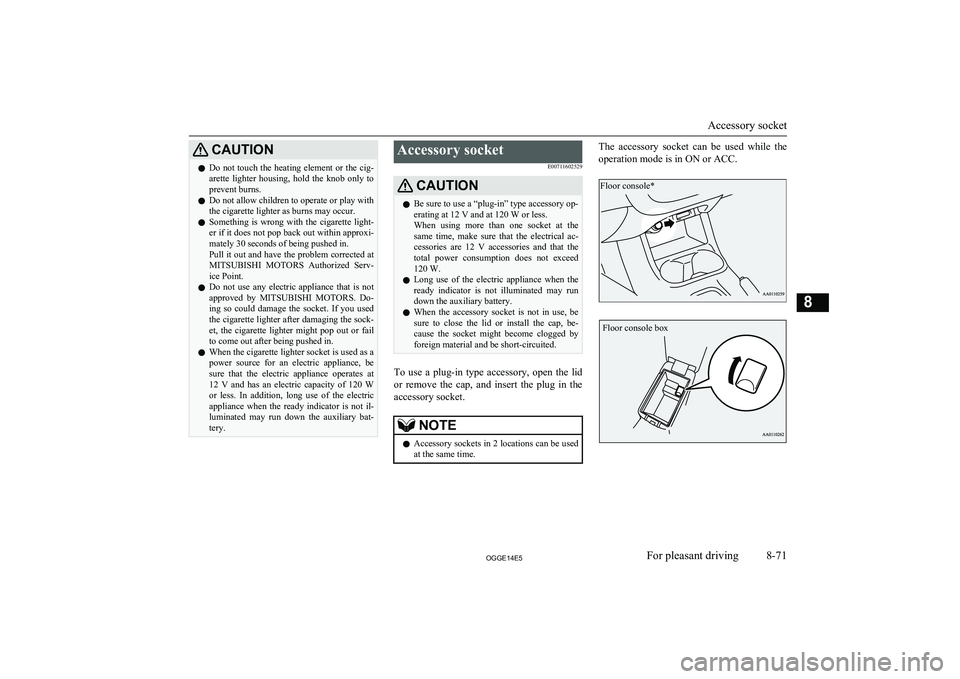
CAUTIONlDo not touch the heating element or the cig-
arette lighter housing, hold the knob only to prevent burns.
l Do not allow children to operate or play with
the cigarette lighter as burns may occur.
l Something is wrong with the cigarette light-
er if it does not pop back out within approxi-
mately 30 seconds of being pushed in.
Pull it out and have the problem corrected at MITSUBISHI MOTORS Authorized Serv-
ice Point.
l Do not use any electric appliance that is not
approved by MITSUBISHI MOTORS . Do-
ing so could damage the socket. If you used
the cigarette lighter after damaging the sock- et, the cigarette lighter might pop out or fail
to come out after being pushed in.
l When the cigarette lighter socket is used as a
power source for an electric appliance, be sure that the electric appliance operates at
12 V and has an electric capacity of 120 W or less. In addition, long use of the electricappliance when the ready indicator is not il-
luminated may run down the auxiliary bat- tery.Accessory socket
E00711602529CAUTIONlBe sure to use a “plug-in” type accessory op-
erating at 12 V and at 120 W or less.
When using more than one socket at the same time, make sure that the electrical ac-
cessories are 12 V accessories and that the total power consumption does not exceed
120 W.
l Long use of the electric appliance when the
ready indicator is not illuminated may run
down the auxiliary battery.
l When the accessory socket is not in use, be
sure to close the lid or install the cap, be-
cause the socket might become clogged by foreign material and be short-circuited.
To use a plug-in type accessory, open the lid
or remove the cap, and insert the plug in the accessory socket.
NOTEl Accessory sockets in 2 locations can be used
at the same time.The accessory socket can be used while the
operation mode is in ON or ACC.
Accessory socket
8-71OGGE14E5For pleasant driving8 Floor console* Floor console box
Page 340 of 442
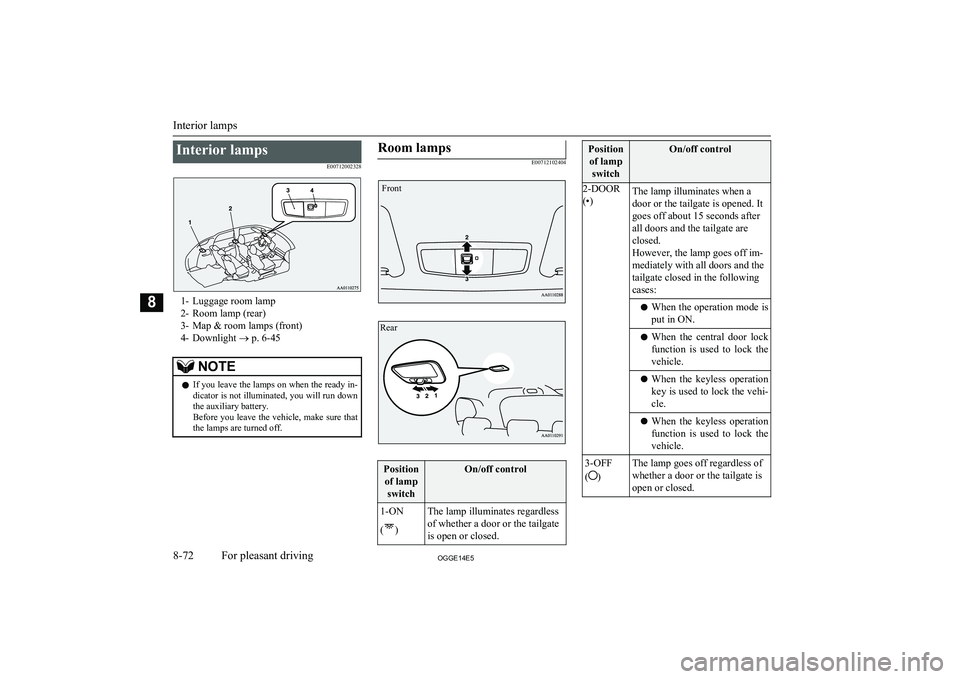
Interior lampsE00712002328
1- Luggage room lamp
2- Room lamp (rear)
3- Map & room lamps (front)
4- Downlight ® p. 6-45
NOTEl If you leave the lamps on when the ready in-
dicator is not illuminated, you will run down the auxiliary battery.
Before you leave the vehicle, make sure that
the lamps are turned off.Room lamps
E00712102404
Position
of lamp switchOn/off control1-ON
(
)
The lamp illuminates regardless
of whether a door or the tailgate
is open or closed.Position of lamp switchOn/off control2-DOOR
(•)The lamp illuminates when a
door or the tailgate is opened. It
goes off about 15 seconds after
all doors and the tailgate are
closed.
However, the lamp goes off im-
mediately with all doors and the
tailgate closed in the following
cases:l When the operation mode is
put in ON.l When the central door lock
function is used to lock thevehicle.l When the keyless operation
key is used to lock the vehi-cle.l When the keyless operation
function is used to lock thevehicle.3-OFF
(
)
The lamp goes off regardless of
whether a door or the tailgate is
open or closed.
Interior lamps
8-72OGGE14E5For pleasant driving8 Front Rear
Page 341 of 442
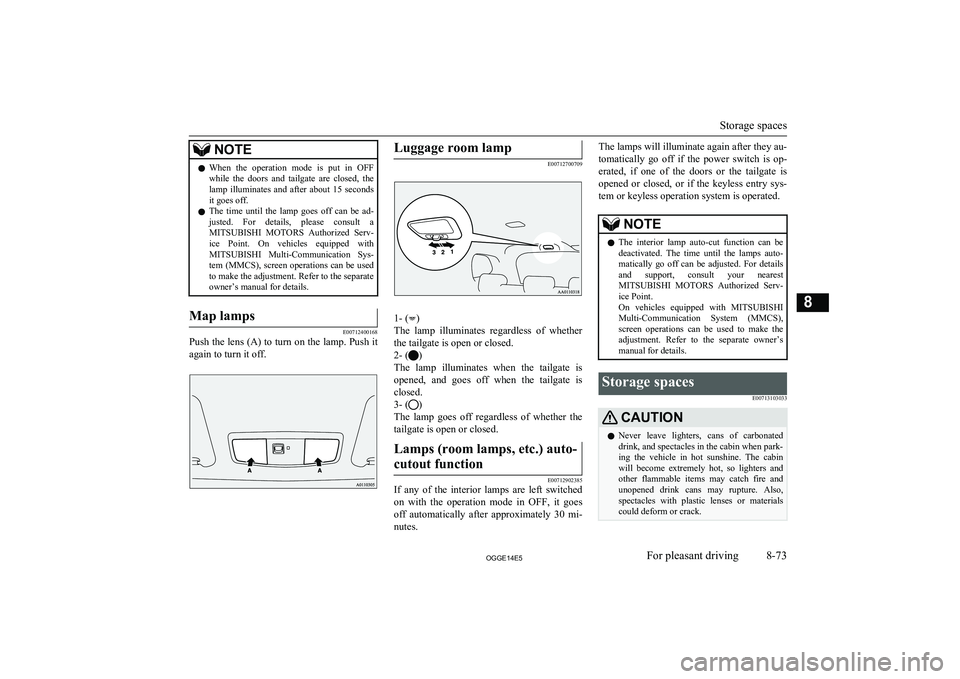
NOTElWhen the operation mode is put in OFF
while the doors and tailgate are closed, the
lamp illuminates and after about 15 seconds it goes off.
l The time until the lamp goes off can be ad-
justed. For details, please consult a
MITSUBISHI MOTORS Authorized Serv-
ice Point. On vehicles equipped with
MITSUBISHI Multi-Communication Sys-
tem (MMCS), screen operations can be used
to make the adjustment. Refer to the separate
owner’s manual for details.Map lamps
E00712400168
Push the lens (A) to turn on the lamp. Push it
again to turn it off.
Luggage room lamp
E00712700709
1- ()
The lamp illuminates regardless of whether the tailgate is open or closed.
2- (
)
The lamp illuminates when the tailgate is opened, and goes off when the tailgate is
closed.
3- (
)
The lamp goes off regardless of whether the tailgate is open or closed.
Lamps (room lamps, etc.) auto-
cutout function
E00712902385
If any of the interior lamps are left switched on with the operation mode in OFF, it goesoff automatically after approximately 30 mi-
nutes.
The lamps will illuminate again after they au-
tomatically go off if the power switch is op-
erated, if one of the doors or the tailgate is opened or closed, or if the keyless entry sys-
tem or keyless operation system is operated.NOTEl The interior lamp auto-cut function can be
deactivated. The time until the lamps auto- matically go off can be adjusted. For details
and support, consult your nearest
MITSUBISHI MOTORS Authorized Serv-
ice Point.
On vehicles equipped with MITSUBISHI
Multi-Communication System (MMCS),
screen operations can be used to make the adjustment. Refer to the separate owner’s
manual for details.Storage spaces
E00713103033CAUTIONlNever leave lighters, cans of carbonated
drink, and spectacles in the cabin when park-ing the vehicle in hot sunshine. The cabin will become extremely hot, so lighters and
other flammable items may catch fire and unopened drink cans may rupture. Also,spectacles with plastic lenses or materials
could deform or crack.
Storage spaces
8-73OGGE14E5For pleasant driving8
Page 348 of 442
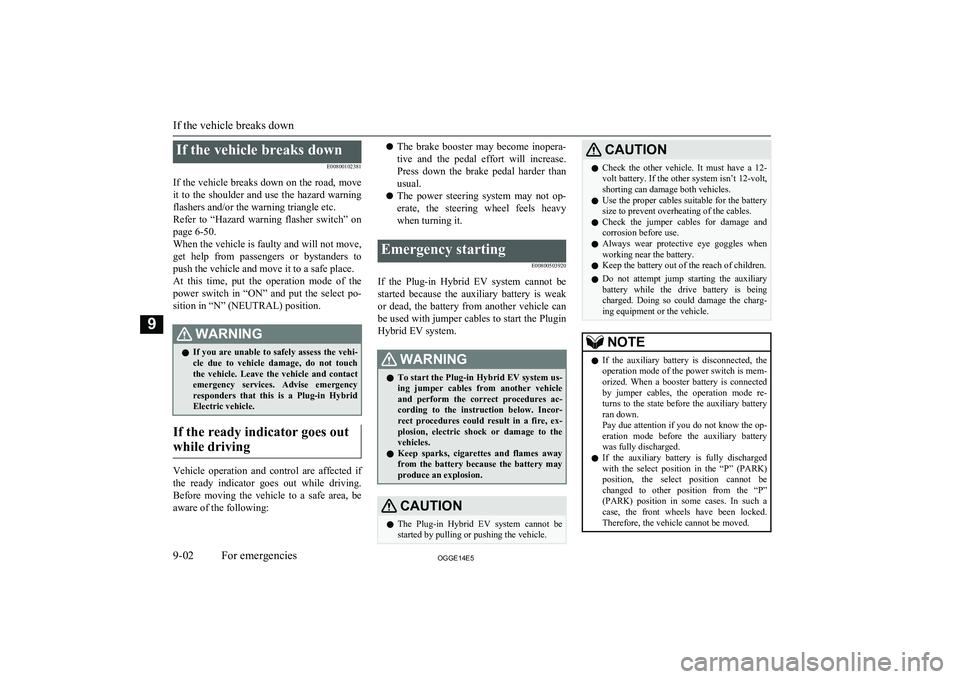
If the vehicle breaks downE00800102381
If the vehicle breaks down on the road, move it to the shoulder and use the hazard warning
flashers and/or the warning triangle etc.
Refer to “Hazard warning flasher switch” on page 6-50.
When the vehicle is faulty and will not move,
get help from passengers or bystanders to
push the vehicle and move it to a safe place.
At this time, put the operation mode of the power switch in “ON” and put the select po-sition in “N” (NEUTRAL) position.WARNINGl If you are unable to safely assess the vehi-
cle due to vehicle damage, do not touch
the vehicle. Leave the vehicle and contact emergency services. Advise emergency
responders that this is a Plug-in Hybrid Electric vehicle.
If the ready indicator goes out
while driving
Vehicle operation and control are affected if
the ready indicator goes out while driving.
Before moving the vehicle to a safe area, be aware of the following:
l The brake booster may become inopera-
tive and the pedal effort will increase.
Press down the brake pedal harder than usual.
l The power steering system may not op-
erate, the steering wheel feels heavy when turning it.Emergency starting
E00800503920
If the Plug-in Hybrid EV system cannot be
started because the auxiliary battery is weak or dead, the battery from another vehicle can
be used with jumper cables to start the Plugin
Hybrid EV system.
WARNINGl To start the Plug-in Hybrid EV system us-
ing jumper cables from another vehicle
and perform the correct procedures ac-
cording to the instruction below. Incor- rect procedures could result in a fire, ex-
plosion, electric shock or damage to the
vehicles.
l Keep sparks, cigarettes and flames away
from the battery because the battery may
produce an explosion.CAUTIONl The Plug-in Hybrid EV system cannot be
started by pulling or pushing the vehicle.CAUTIONl Check the other vehicle. It must have a 12-
volt battery. If the other system isn’t 12-volt,shorting can damage both vehicles.
l Use the proper cables suitable for the battery
size to prevent overheating of the cables.
l Check the jumper cables for damage and
corrosion before use.
l Always wear protective eye goggles when
working near the battery.
l Keep the battery out of the reach of children.
l Do not attempt jump starting the auxiliary
battery while the drive battery is being charged. Doing so could damage the charg-
ing equipment or the vehicle.NOTEl If the auxiliary battery is disconnected, the
operation mode of the power switch is mem-
orized. When a booster battery is connected
by jumper cables, the operation mode re- turns to the state before the auxiliary battery
ran down.
Pay due attention if you do not know the op-
eration mode before the auxiliary battery
was fully discharged.
l If the auxiliary battery is fully discharged
with the select position in the “P” (PARK)
position, the select position cannot be changed to other position from the “P”
(PARK) position in some cases. In such a case, the front wheels have been locked.
Therefore, the vehicle cannot be moved.
If the vehicle breaks down
9-02OGGE14E5For emergencies9
Page 366 of 442
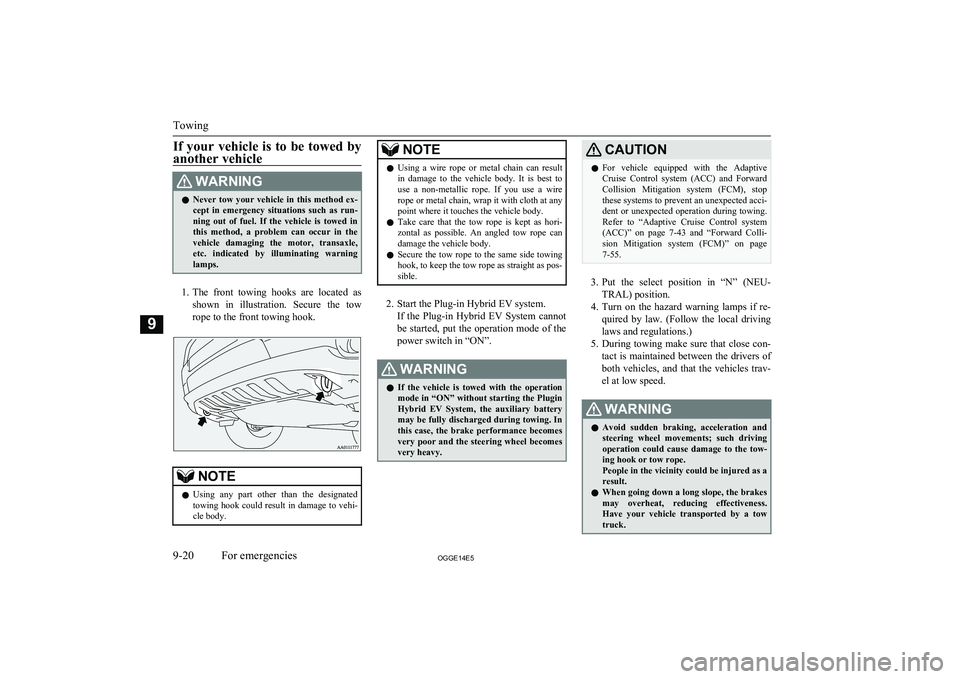
If your vehicle is to be towed by
another vehicleWARNINGl Never tow your vehicle in this method ex-
cept in emergency situations such as run-
ning out of fuel. If the vehicle is towed in this method, a problem can occur in thevehicle damaging the motor, transaxle,
etc. indicated by illuminating warning lamps.
1. The front towing hooks are located as
shown in illustration. Secure the tow rope to the front towing hook.
NOTEl Using any part other than the designated
towing hook could result in damage to vehi-cle body.NOTEl Using a wire rope or metal chain can result
in damage to the vehicle body. It is best to use a non-metallic rope. If you use a wire
rope or metal chain, wrap it with cloth at any
point where it touches the vehicle body.
l Take care that the tow rope is kept as hori-
zontal as possible. An angled tow rope can
damage the vehicle body.
l Secure the tow rope to the same side towing
hook, to keep the tow rope as straight as pos-
sible.
2. Start the Plug-in Hybrid EV system.
If the Plug-in Hybrid EV System cannotbe started, put the operation mode of the
power switch in “ON”.
WARNINGl If the vehicle is towed with the operation
mode in “ON” without starting the Plugin
Hybrid EV System, the auxiliary battery may be fully discharged during towing. In
this case, the brake performance becomes very poor and the steering wheel becomes
very heavy.CAUTIONl For vehicle equipped with the Adaptive
Cruise Control system (ACC) and Forward Collision Mitigation system (FCM), stopthese systems to prevent an unexpected acci-
dent or unexpected operation during towing. Refer to “Adaptive Cruise Control system
(ACC)” on page 7-43 and “Forward Colli-
sion Mitigation system (FCM)” on page 7-55.
3. Put the select position in “N” (NEU-
TRAL) position.
4. Turn on the hazard warning lamps if re-
quired by law. (Follow the local driving
laws and regulations.)
5. During towing make sure that close con-
tact is maintained between the drivers of
both vehicles, and that the vehicles trav-
el at low speed.
WARNINGl Avoid sudden braking, acceleration and
steering wheel movements; such driving
operation could cause damage to the tow- ing hook or tow rope.
People in the vicinity could be injured as a
result.
l When going down a long slope, the brakes
may overheat, reducing effectiveness.
Have your vehicle transported by a tow truck.
Towing
9-20OGGE14E5For emergencies9
Page 378 of 442

Service precautionsE01000102058
Adequate care of your vehicle at regular in- tervals serves to preserve the value and ap-
pearance as long as possible.
Maintenance items as described in this own- er’s manual can be performed by the owner.We recommend you to have the periodic in-
spection and maintenance performed by a MITSUBISHI MOTORS Authorized Service
Point or another specialist.In the event a malfunction or a problem is discovered, we recommend you to have it
checked and repaired. This section contains information on inspection maintenance pro- cedures that you can do yourself. Follow theinstructions and cautions for each of the vari-
ous procedures.
A- Cooling fans B- Caution label
C- Radiator cap
D- EV cooling reserve tank cap
*: Front of the vehicleWARNINGlBefore performing inspection or mainte-
nance, be sure to disconnect the normal charge connector from the vehicle andconfirm that the operation mode of the power switch is set to “OFF”.
l Never touch the high-voltage parts in the
engine compartment. Never remove or disassemble the high-voltage components,
cables (orange) or connectors. Also, never disassemble normal charging cables, nor-
mal charge connector, plugs or outlet. Failure to observe this instruction could
cause an electric shock which can result in
a serious injury or death. These parts have labels that indicate handling precau-
tions. Follow the instruction on these la- bels. Contact a MITSUBISHI MOTORS
Authorized Service Point for any necessa-
ry maintenance.
Refer to “High-Voltage components” on page 2-07.
l When checking or servicing the inside of
the engine compartment, make sure the
plug-in hybrid EV system is switched off and has had a chance to cool down.
Service precautions
11-02OGGE14E5Maintenance11
Page 379 of 442
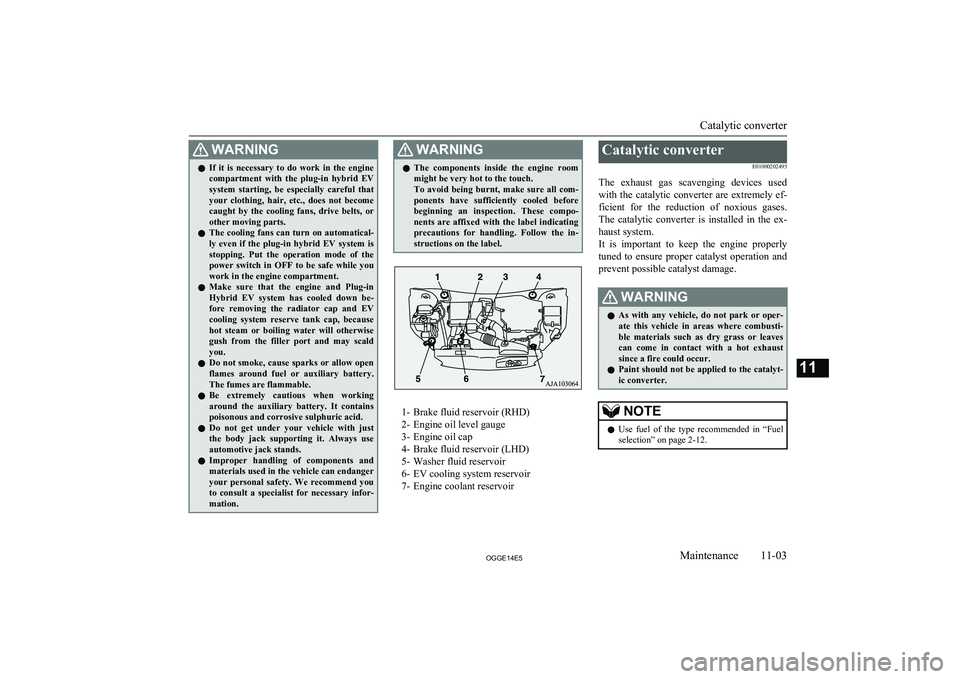
WARNINGlIf it is necessary to do work in the engine
compartment with the plug-in hybrid EV
system starting, be especially careful that
your clothing, hair, etc., does not become caught by the cooling fans, drive belts, orother moving parts.
l The cooling fans can turn on automatical-
ly even if the plug-in hybrid EV system is
stopping. Put the operation mode of the
power switch in OFF to be safe while you work in the engine compartment.
l Make sure that the engine and Plug-in
Hybrid EV system has cooled down be- fore removing the radiator cap and EV
cooling system reserve tank cap, because hot steam or boiling water will otherwise
gush from the filler port and may scald you.
l Do not smoke, cause sparks or allow open
flames around fuel or auxiliary battery.
The fumes are flammable.
l Be extremely cautious when working
around the auxiliary battery. It contains
poisonous and corrosive sulphuric acid.
l Do not get under your vehicle with just
the body jack supporting it. Always use automotive jack stands.
l Improper handling of components and
materials used in the vehicle can endangeryour personal safety. We recommend you to consult a specialist for necessary infor-
mation.WARNINGl The components inside the engine room
might be very hot to the touch.
To avoid being burnt, make sure all com- ponents have sufficiently cooled before beginning an inspection. These compo-
nents are affixed with the label indicating precautions for handling. Follow the in-structions on the label.
1- Brake fluid reservoir (RHD)
2- Engine oil level gauge
3- Engine oil cap
4- Brake fluid reservoir (LHD)
5- Washer fluid reservoir
6- EV cooling system reservoir
7- Engine coolant reservoir
Catalytic converter
E01000202495
The exhaust gas scavenging devices used with the catalytic converter are extremely ef- ficient for the reduction of noxious gases.
The catalytic converter is installed in the ex- haust system.
It is important to keep the engine properly
tuned to ensure proper catalyst operation and prevent possible catalyst damage.WARNINGl As with any vehicle, do not park or oper-
ate this vehicle in areas where combusti- ble materials such as dry grass or leaves
can come in contact with a hot exhaust
since a fire could occur.
l Paint should not be applied to the catalyt-
ic converter.NOTEl Use fuel of the type recommended in
“Fuel
selection” on page 2-12.
Catalytic converter
11-03OGGE14E5Maintenance11
Page 414 of 442
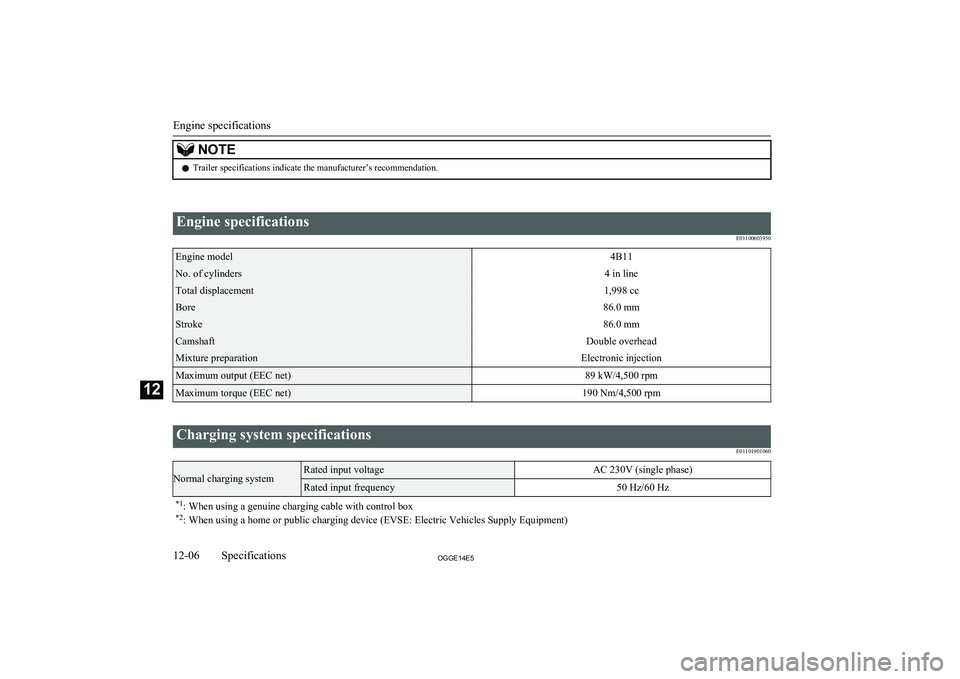
NOTElTrailer specifications indicate the manufacturer’s recommendation.
Engine specifications
E01100603950Engine model4B11No. of cylinders4 in lineTotal displacement1,998 ccBore86.0 mmStroke86.0 mmCamshaftDouble overheadMixture preparationElectronic injectionMaximum output (EEC net)89 kW/4,500 rpmMaximum torque (EEC net)190 Nm/4,500 rpm
Charging system specifications E01101901060Normal charging systemRated input voltageAC 230V (single phase)Rated input frequency50 Hz/60 Hz*1: When using a genuine charging cable with control box
*2 : When using a home or public charging device (EVSE: Electric Vehicles Supply Equipment)
Engine specifications
12-06OGGE14E5Specifications12
Page 432 of 442
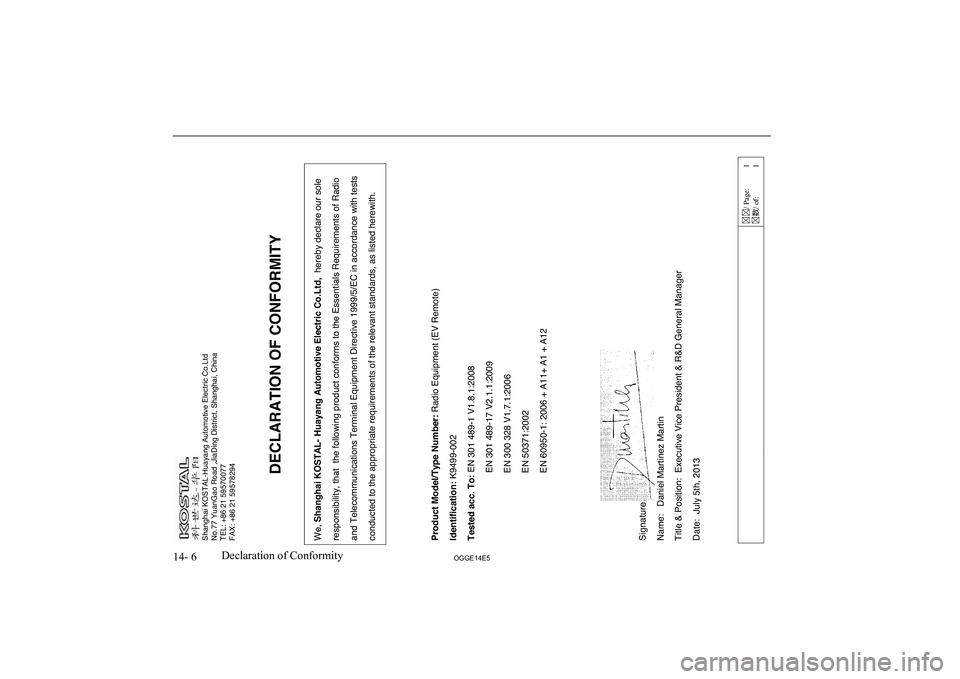
14- 6OGGE14E5Declaration of Conformity Shanghai KOSTAL-Huayang Automotive Electric Co.Ltd
No.77 YuanGao Road ,JiaDing District, Shanghai, China
TEL: +86 21 59570077
FAX: +86 21 59578294
/ Page: 1
: / of: 1
DECLARATION OF CONFORMITY
We, Shanghai KOSTAL- Huayang Automotive Electric Co.Lt d, hereby declare our sole
responsibility, that the following product conforms t o the Essentials Requirements of Radio
and Telecommunications Terminal Equipment Directive 1 999/5/EC in accordance with tests
conducted to the appropriate requirements of the relev ant standards, as listed herewith.
Product Model/Type Number: Radio Equipment (EV Remote)
Identification: K9499-002
Tested acc. To: EN 301 489-1 V1.8.1:2008
EN 301 489-17 V2.1.1:2009
EN 300 328 V1.7.1:2006
EN 50371:2002
EN 60950-1: 2006 + A11+ A1 + A12
Signature:
Name: Daniel Martinez Martin
Title & Position: Executive Vice President & R&D Gen eral Manager
Date: July 5th, 2013